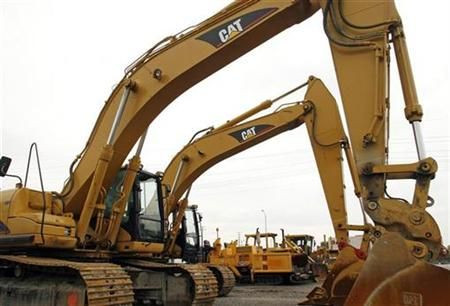Caterpillar Inc. (CAT) Q2 Profit Rises, Lifts 2012 Forecast

Caterpillar Inc. (NYSE: CAT), the largest maker of construction and mining equipment, reported a 67 percent jump in its second-quarter profit that topped analysts' estimates and boosted its full-year outlook as demand increased from North American builders and overseas miners.
Shares of Caterpillar soared $3.75, or 4.61 percent, to $85.18 a share in Wednesday's pre-market trading. So far this year, the shares have lost 10.12 percent.
The Peoria, Ill.-based company, a bellwether of the global economy, raised its 2012 profit outlook to $9.60 a share, compared with a previous forecast of $9.50 a share. But the company cut the high-end of its revenue guidance by $2 billion, now expecting $68 billion to $70 billion, citing weaker economic conditions in much of the world and about $1 billion of negative currency impacts.
Caterpillar earned $1.7 billion, or $2.54 per share, from $1.02 billion, or $1.52, a year earlier, the company said in a statement on Wednesday. Analysts, on average, were expecting earnings of $2.28 per share.
Revenue rose 21 percent to $17.37 billion. Analysts expected $17.11 billion. Backlog declined to $28.2 billion on an implied order decline of 3 percent.
Caterpillar's success in 2012 is occurring despite U.S. construction activity that remains depressed and well below the prior peak, the problems facing Eurozone economies and economic concerns in China, Chief Executive Doug Oberhelman said in a statement. While we're expecting a record year in 2012, we understand the world is facing economic challenges, and if it becomes necessary, we are prepared to act quickly as we did in late 2008 and 2009.
Caterpillar competes with CNH Global NV (NYSE: CNH), Deere & Co. (NYSE: DE), Joy Global Inc. (NYSE: JOY), Cummins Inc. (NYSE: CMI) and Astec Industries Inc. (Nasdaq: ASTE).
Replacement Needs
Caterpillar retail sales demonstrated continued strength in June, with machines generating double-digit year-over-year growth for the 25nd consecutive month, according to the latest data available.
Replacement demand in North America is still strong and utilization rates at rental agencies are pretty decent, Fleck said ahead of the earnings report. Given that both residential and commercial constructions continue to increase here in the first part of the year, it seems like activity has picked up, which would necessitate more equipment.
The average age of machines in dealer rental fleets was at a historically high level in 2011. While that number has come down to 48.9 months in May of 2012, from a high of 53.3 months in February 2011, the utilization rates in the U.S. are still higher than ever and Caterpillar expects U.S. construction equipment replacement to maintain its momentum.
We are coming off such a low base, so I think the replacement demand is likely to continue for some time here, Fleck said. These companies have let their equipment age pretty dramatically and there needs to be some replacement.
Low interest rates and small improvements in construction spending should encourage replacement demand in North America.
U.S. companies borrowed more to buy equipment in May of 2012 than a year ago, as they replaced worn-out equipment after deferring such activity during the U.S. economic recession in 2008 and the subsequent sluggish recovery, data released by the Equipment Leasing and Finance Association showed.
Companies financed $6.2 billion of new equipment last month, up from $5.6 billion in the year-earlier period.
Mining Demand
Mining equipment accounts for about a third of Caterpillar's total revenue.
Caterpillar noted that mining remained strong in every region except for U.S. coal, which is not a big percentage of Caterpillar's business.
U.S. coal prices declined enough to cause coal mines to reduce both production and investment, the company said in a Wednesday statement.
Recently published electric power data for April show that, for the first time since the U.S. Energy Information Administration began collecting the data, generation from natural gas-fired plants is virtually equal to generation from coal-fired plants, with each fuel providing 32 percent of total generation.
Five years ago, coal captured 50 percent of net generation and natural gas was only a little more than 20 percent.
Railroad operator CSX Corp. (NSYE: CSX), a big mover of coal from mines to seaports, confirmed the decline in coal shipment during the company's second-quarter earnings release last week. Coal accounts for more than one-fourth of CSX's revenue, and shipment volumes of that were down by 37 percent.
Competitor Joy Global Inc. (NYSE: JOY) cut its full-year guidance on May 31 citing mild winter weather and competition from cheap natural gas, which have left U.S. coal producers with large stockpiles.
Roughly 5 percent of caterpillar's total revenues are generated from U.S. coal, including Bucyrus, which mainly focuses on the U.S. coal market.
While Bucyrus is not immune to the decline in commodity prices, there's synergy to be captured.
With the acquisition of Bucyrus, Caterpillar can now address 90 percent of the market, compared with 25 percent before, according to a June management call. And Caterpillar's competitors can only address 50 percent of the market.
Caterpillar has alliance agreements with about 15 of the world's largest mining companies, and these customers get better pricing as they increase the size of the purchase, Ann Duignan, an analyst at JPMorgan Chase & Co., wrote in a May 25 note. She rates Caterpillar a BUY with a price target of $132 for the year.
Caterpillar will leverage this going forward as it provides a 'win' for both parties and is at the core of its rationale for acquiring Bucyrus, Duignan said.
The area that Bucyrus has always struggled in was aftermarket sales, which wasn't as strong as Joy Global's is. As a result, Bucyrus's margin was a little bit lower. So Caterpillar has the opportunity to increase that margin, which could offset some of the weakness in U.S. coal, according to Fleck.
© Copyright IBTimes 2024. All rights reserved.






















